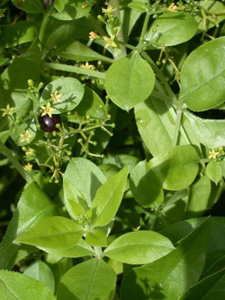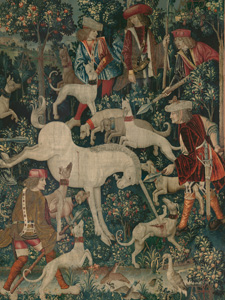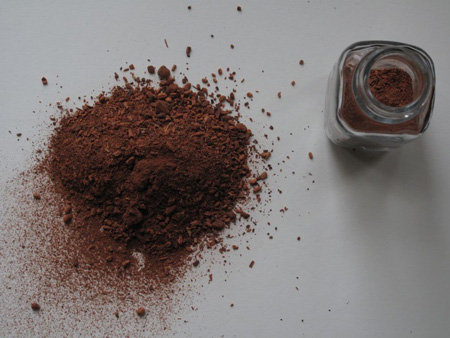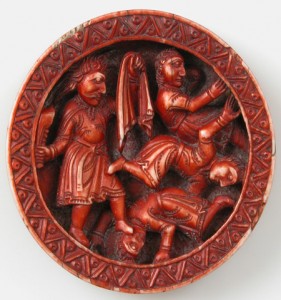No mader, welde, or wood no litestre
Ne knew; the flees was of his former hewe;
Ne flesh ne wiste offence of egge or spere.
No coyn ne knew man which was fals or trewe,
No ship yet karf the wawes grene and blewe,
No marchaunt yit ne fette outlandish ware.???Geoffrey Chaucer, The Former Age, ll. 17???22
Above, left: Dyer’s madder, a rough perennial herb native from the Eastern Mediterranean to Central Asia, grows in the bed devoted to plants used in medieval arts and crafts in Bonnefont cloister. The dried and pulverized roots of madder afforded a strong, fast red. Right: Detail from The Unicorn Defends Itself (from the Unicorn Tapestries). A range of colors???from pinks through bright reds, purplish reds, and oranges???could be achieved with madder, depending on the mordant used and the way in which the madder was combined with other colorants. (See Collections for more information about this work of art.)
The antiquity of the dyer’s craft is conveyed by Chaucer’s inclusion of the ignorance of madder, weld, and woad, the holy trinity of medieval dye plants, in his description of a period so remote and so devoid of the arts of civilization as to predate the use of knives, spears, coins, and ships. The use of madder is especially ancient, as demonstrated by this fragment of an Egyptian leather quiver in the Museum’s collection that may date to the 3rd millennium B.C.
While a number of plants in the genus Rubia have been exploited as dyestuffs, the most important of these in medieval European textile manufacture was Rubia tinctorum. This madder was introduced to Greco-Roman civilization from the East, where its use was long established. Both Dioscorides and the Roman natural historian Pliny note its economic importance as a cultivated plant; Pliny remarks that the madder plant is best known to the sordid and avaricious, because of the great profits entailed in growing it for coloring both wool and leather. He goes on to say that Italian madder is the most esteemed, although it is grown abundantly in nearly all the provinces of the Empire. In the Middle Ages, madder the Italian cities of Florence, Genoa, and Pisa were flourishing dye-trade cities; the fortunes of the great Florentine family of sculptors and ceramicists, the Della Robbia, were founded in the textile trade, and their name derives from rubia, the Italian for madder.
Above: A jar of ground madder root displayed in the garden shed; the dyestuff is prepared from the dried roots of plants that are at least two years old; the older the plant, the stronger the colorant.
Madder appears in the list of desirable plants to be cultivated on the imperial estates in the Carolingian edict De Capitulare Villis. (For more on this important document, and a list of the plants specified, visit the Wyrtig website.
Madder cultivation was well established in France in the course of the Middle Ages, although the center of madder production moved to the lowlands of Northern Europe, which was also the center for tapestry production. Standards to ensure the quality of the madder roots produced were decreed and enforced in European markets, and legal action was taken against those who supplied inferior roots or adulterated madder with other colorants. For a discussion of madder’s characteristics and a succinct history of its use in pre-modern times, see William Legget, Ancient and Medieval Dyes (p. 9???20).
Above: This twelfth-century game piece, depicting Samson wielding the jawbone of an ass against the Philistines, is made from elephant ivory colored with madder root. Although madder was of great importance in the medieval textile industry, its use was not restricted to dyeing cloth. (See Collections to learn more about this work of art.)
Alizarin, the principal colorant present in processed madder root, was the first natural pigment to be synthesized in 1868; by 1871 it was discovered that alizarin could be abstracted from coal tar. The ready availability of a cheap synthetic alizarin led to the collapse of the long-established economic market for madder, although the vibrancy of madder red, whose components include more than twenty-five other coloring agents beside alizarin, greatly exceeds that of a synthetic chemical dye. This was recognized by the nineteenth-century textile designer William Morris, who asserted that the art of dyeing depended on the use of ancient colorants like those mentioned in Pliny, and that no textiles of artistic value could be produced using contemporary commercial methods.
???Deirdre Larkin
Sources:
Cannon, John and Margaret. Dye Plants and Dyeing. Illustrated by Gretel Dalby-Quenet. Published in association with Royal Botanic Gardens, Kew. London: Herbert Press, 1994.
Cenciner, Robert. Madder Red: A History of luxury and trade. Richmond, England: Curzon Press, Reprinted 2001.
Freeman, Margaret B. The Unicorn Tapestries. New York: E. P. Dutton, Inc., 1956.
Tags: Dioscorides, dye, madder, Pliny, Rubia tinctorum, Unicorn tapestries





March 21, 2013 at 5:50 pm
Thank you for all the work put into these blogs. Always interesting, there’s so much to learn. The links, pictures, seasonal interest….definately worth the time.